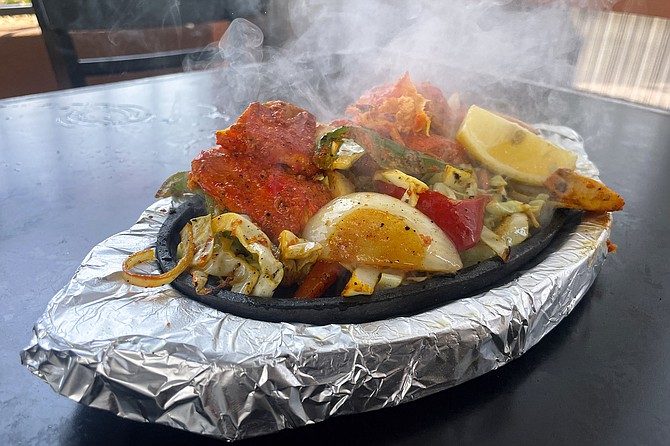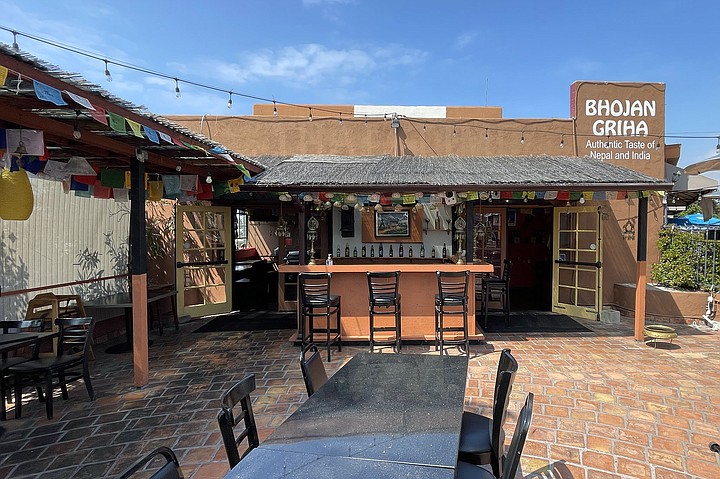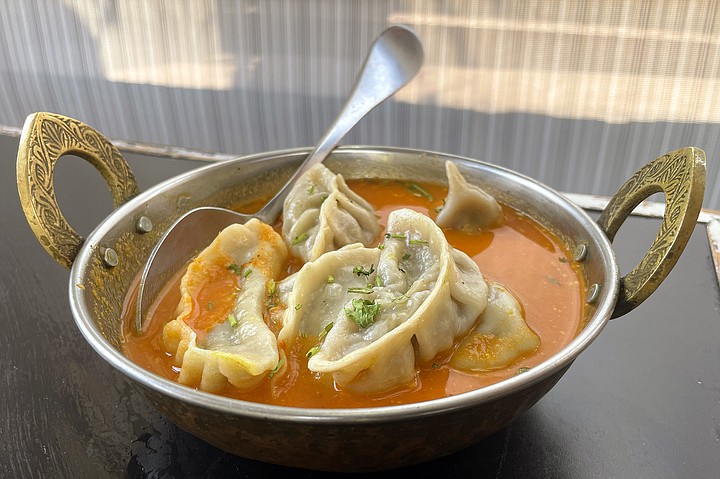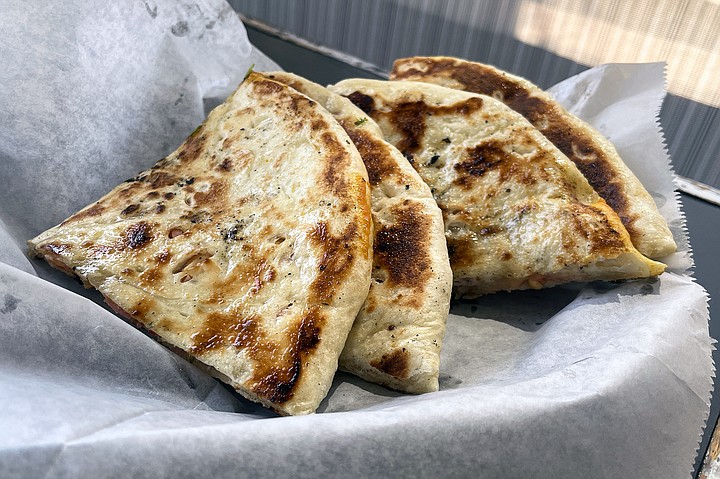 Facebook
Facebook
 X
X
 Instagram
Instagram
 TikTok
TikTok
 Youtube
Youtube

If you’ve never noticed how closely Tibetan prayer flags can resemble papel picado, take a walk around Old Town’s San Diego Avenue. The varicolored rows of paper squares you’ll see strung up around Mexican restaurants and souvenir shops represent papel picado, the decorative Mexican folk craft that involves sometimes elaborate paper cutout patterns. It’s when you spot varicolored rows of fabric squares that you’ll know you’ve reached the restaurant, Bhojan Griha.
Without a closer look, a casual passerby might glance at the mix of blue, green, red, and yellow flags and assume they’re outside yet another Mexican restaurant in Old Town. However, while strung up in a similar fashion, these decorative prayer flags are printed with the sort of Buddhist invocations employed by communities of Tibet and Nepal. Bhojan Griha is Nepali for “house of dining,” and it specializes in Himalayan cuisines, drawing on traditional dishes of those two mountain cultures, as well as India.

What a South Asian restaurant is doing nestled within a tourist hub better known for enchiladas and Mariachi music, I won’t speculate. But I can say it’s one of the better such eateries in any part of town. Most of what turns out to be a fairly extensive menu matches up with what we’re used to finding at Indian restaurants, including a comprehensive list of distinct curries: korma, kadai, makhani, masala, and vindaloo, for starters. It would be great fun to focus only on curries, to compare and contrast them all.
However, Bhojan Griha was named after a large restaurant in Kathmandu, so I felt compelled to bypass the curries in favor of Nepali and Tibetan dishes. Considering everything I know about these cuisines would probably fit inside a dumpling, that meant starting with a selection from the momo menu.
Momos are a style of dumplings eaten in the Himalayas, which may be steamed or pan-fried. Bhojan Griha offers them either way, but I’ve tried just enough momos in my life to know I prefer jhol momos ($13-16), which are steamed, yet served swimming in a semi-spicy, sesame and tomato soup. As I knew I’d be trying several meat dishes during the meal, I skipped chicken and lamb dumpling options in favor of a diced vegetable filling, which most heavily featured cabbage. Though tasty in that broth, these probably aren’t as fun to eat as the meaty versions.

Another Nepali appetizer proved new to me: haku choila ($11-13). Had I tried the chicken version of this dish, I could liken it to a spicy chicken salad. Though I opted for lamb, it amounted to the same thing: roasted meat, peppers, and onions, mixed together in a spicy sesame paste. The biggest surprise for me here isn’t that it was served cold, but that it tasted so good that way. When the haku choila got to the table, I looked around for my order of rice or naan flatbread, but neither had arrived yet, so I quickly learned the dish didn’t need accompaniment.
When my naan did arrive, it wasn’t a good match anyway. Because, rather than opt for a garlic or cheese naan, I tried my first Badami naan. The word Badami means “almond,” and this flatbread certainly was stuffed with crushed almonds. There were also cashews and peanuts in there, but what really stand out were the diced cherries and fennel seeds. This was more a dessert naan, with a perceived sweetness, and flavor I’d consider unique among pastries, let alone among flatbreads.

I’d love to have had garlic naan handy when my final dish arrived: salmon tandoori. This place cooks various foods in its resident clay oven, so a choice had to be made between chicken, lamb, and fish ($21-22). The next table made the decision for us when their salmon came out, still sizzling and steaming in its pan. That would have been the case with whichever protein, but no regrets trying the tantalizing fish.
Other than for a small kitchen and dining room, Bhojan Griha would be considered an outdoor restaurant — it’s prayer flags surround a large, enclosed courtyard with plenty of shaded seating. It wouldn’t be tough to imagine a small musical troupe showing up at our table to sing “Guantanamera.” Instead, you get South Asian pop music and loads of heavy spice blends. And just as memorable an Old Town experience.


If you’ve never noticed how closely Tibetan prayer flags can resemble papel picado, take a walk around Old Town’s San Diego Avenue. The varicolored rows of paper squares you’ll see strung up around Mexican restaurants and souvenir shops represent papel picado, the decorative Mexican folk craft that involves sometimes elaborate paper cutout patterns. It’s when you spot varicolored rows of fabric squares that you’ll know you’ve reached the restaurant, Bhojan Griha.
Without a closer look, a casual passerby might glance at the mix of blue, green, red, and yellow flags and assume they’re outside yet another Mexican restaurant in Old Town. However, while strung up in a similar fashion, these decorative prayer flags are printed with the sort of Buddhist invocations employed by communities of Tibet and Nepal. Bhojan Griha is Nepali for “house of dining,” and it specializes in Himalayan cuisines, drawing on traditional dishes of those two mountain cultures, as well as India.

What a South Asian restaurant is doing nestled within a tourist hub better known for enchiladas and Mariachi music, I won’t speculate. But I can say it’s one of the better such eateries in any part of town. Most of what turns out to be a fairly extensive menu matches up with what we’re used to finding at Indian restaurants, including a comprehensive list of distinct curries: korma, kadai, makhani, masala, and vindaloo, for starters. It would be great fun to focus only on curries, to compare and contrast them all.
However, Bhojan Griha was named after a large restaurant in Kathmandu, so I felt compelled to bypass the curries in favor of Nepali and Tibetan dishes. Considering everything I know about these cuisines would probably fit inside a dumpling, that meant starting with a selection from the momo menu.
Momos are a style of dumplings eaten in the Himalayas, which may be steamed or pan-fried. Bhojan Griha offers them either way, but I’ve tried just enough momos in my life to know I prefer jhol momos ($13-16), which are steamed, yet served swimming in a semi-spicy, sesame and tomato soup. As I knew I’d be trying several meat dishes during the meal, I skipped chicken and lamb dumpling options in favor of a diced vegetable filling, which most heavily featured cabbage. Though tasty in that broth, these probably aren’t as fun to eat as the meaty versions.

Another Nepali appetizer proved new to me: haku choila ($11-13). Had I tried the chicken version of this dish, I could liken it to a spicy chicken salad. Though I opted for lamb, it amounted to the same thing: roasted meat, peppers, and onions, mixed together in a spicy sesame paste. The biggest surprise for me here isn’t that it was served cold, but that it tasted so good that way. When the haku choila got to the table, I looked around for my order of rice or naan flatbread, but neither had arrived yet, so I quickly learned the dish didn’t need accompaniment.
When my naan did arrive, it wasn’t a good match anyway. Because, rather than opt for a garlic or cheese naan, I tried my first Badami naan. The word Badami means “almond,” and this flatbread certainly was stuffed with crushed almonds. There were also cashews and peanuts in there, but what really stand out were the diced cherries and fennel seeds. This was more a dessert naan, with a perceived sweetness, and flavor I’d consider unique among pastries, let alone among flatbreads.

I’d love to have had garlic naan handy when my final dish arrived: salmon tandoori. This place cooks various foods in its resident clay oven, so a choice had to be made between chicken, lamb, and fish ($21-22). The next table made the decision for us when their salmon came out, still sizzling and steaming in its pan. That would have been the case with whichever protein, but no regrets trying the tantalizing fish.
Other than for a small kitchen and dining room, Bhojan Griha would be considered an outdoor restaurant — it’s prayer flags surround a large, enclosed courtyard with plenty of shaded seating. It wouldn’t be tough to imagine a small musical troupe showing up at our table to sing “Guantanamera.” Instead, you get South Asian pop music and loads of heavy spice blends. And just as memorable an Old Town experience.
Comments